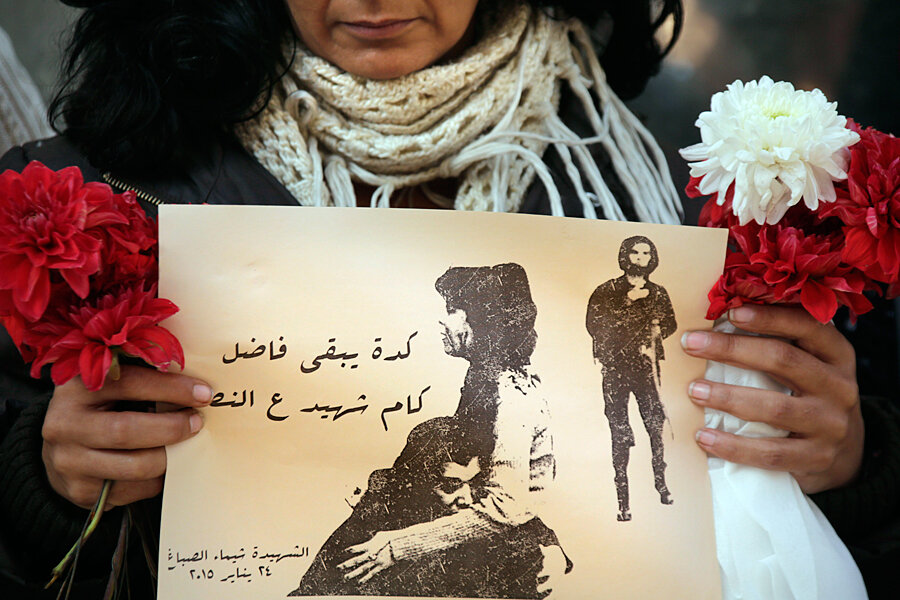Egyptian protester's public killing brings surge of anger over police brutality
Loading...
| Cairo
One moment Shaimaa al-Sabbagh, a young mother and poet, was standing tall on one of Cairo’s busiest thoroughfares. The next, her dying moments were immortalized on film.
The following morning, images of her birdshot-pocked face were splashed across news stands around the world.
Mrs. Sabbagh, who had just participated in a march commemorating Egypt’s 2011 revolution, was neither the first nor the last demonstrator to be shot by Egypt’s police. But her death in late January struck a chord with a protest-weary public in a way not seen since 2010, when the murder of a young Alexandria man, Khaled Said, catalyzed the uprising against Hosni Mubarak.
For both supporters and critics of Egyptian President Abdel Fattah al-Sisi, the former general who overthrew his democratically-elected Islamist predecessor, Mohamed Morsi, Sabbagh’s death has laid bare deep flaws within the country’s security and justice system.
Her shooting has left the state scrambling for cover as it seeks to rehabilitate its reputation on the world stage amid signs Mr. Sisi’s rule is growing more authoritarian. The policeman suspected of causing her death is facing trial, but so are the witnesses to the shooting.
Sabbagh was killed Jan. 24 as she joined a small march carrying a commemorative wreath to the revolution’s most famous landmark, Tahrir Square.
“Everyone knows that a girl with flowers was shot near the square where the revolution took place, even if they have no idea of what else is happening in Egypt,” says Sabbagh’s friend and colleague Hakeem Abdel Naem. “No one can forget that picture.”
Egypt initially maintained that its police force did not kill the poet, despite compelling video evidence to the contrary. Eyewitnesses to the killing appeared in court Saturday, charged with protesting without authorization and disturbing public order. The case was adjourned to May 9 after defense lawyers complained they not been allowed to read the full case file.
Unusual media criticism
But the usually loyal media and the public have been less compliant in this case. Days after Sabbagh’s death, Egypt’s flagship state newspaper published a strikingly critical front-page editorial, blaming the police for her death and hinting at government divisions over how much repression should be tolerated.
Thousands of people have been jailed as part of the fierce crackdown on dissent that followed Sisi’s July 2013 overthrow of Mr. Morsi. Demonstrations have been all but banned.
“The invulnerable facts conveyed by the eyewitness accounts from Shaimaa’s partners in the demonstration, and by the footage of her killing, clearly indicate the killer, the misuse of power, and a failure to implement the law,” wrote Al-Ahram’s editor, Ahmed Sayed Naggar.
This unusual reaction partly stemmed from the emotive nature of the images, as well as her personal biography.
“People seemed to react to something so visual,” says a young software engineer, who asked that his name be withheld for fear of repercussions if he was seen to criticize the state over a sensitive case. “And she wasn’t veiled – so no one could claim she was a member of the Muslim Brotherhood.”
The Islamist movement has been blacklisted as a terrorist organization in Egypt, and the regular deaths of its supporters at wildcat demonstrations garner minimal attention from a hostile public. Few would have been aware that a 17-year-old girl, Sondos Reda Abu Bakr, was killed by the police at a pro-Brotherhood protest in Alexandria the day before Sabbagh’s death.
The Jan. 24 incident also exposed far-reaching problems within Egypt’s police force and judicial system that continue to touch the lives of millions of Egyptians. Police brutality didn't go away after the revolution, and politicized prosecutions are commonplace.
Head of police force sacked
“The police must understand that there is law and it will be applied on them too – they can't avoid it by simply joining the police force,” says Seif Magdy, a Cairo architect who says Sisi has his firm backing. “The government all seem to be doing their best,” he says. “Will they be successful? Only time will give us the answer to that.”
For Mr. Magdy, like many others in Egypt, Sisi is seen as the only option to prevent the country from descending into the sort of chaos seen in neighboring Libya and nearby Syria and Iraq.
Mindful of the delicate task before him, Sisi made one of his biggest moves to date on March 5, sacking Mohamed Ibrahim, the controversial head of Egypt’s police force. Insiders say Sabbagh’s death was one of the last straws for Mr. Ibrahim, who had presided over the worst period of state violence in Egypt’s modern history.
“It wasn’t that the president doesn’t want a firm hand, but the mistakes had started to become embarrassing,” says one government official, who spoke on condition of anonymity.
As Egypt focuses on boosting investment and tourism after four years of turmoil, it has been acutely sensitive to the way Sabbagh’s case has been received internationally. In a letter to the Washington Post, Egypt’s US ambassador disputed the paper’s assertion that witnesses were to be put on trial, calling this Muslim Brotherhood propaganda.
Skepticism about justice
And last Tuesday, Egypt forensic authority dismissed its spokesman just days after he had suggested to the media that Sabbagh had only died from her wounds because she was too thin.
But as the trial of eyewitnesses to Sabbagh’s death got underway Saturday, her friends and family were skeptical that justice will be served.
“I'm now surprised when anything is just these days,” says Mr. Naem. The trial for the policeman accused of causing her death will begin May 10.
“Many will remember her as an icon – but for me, she will remain the Egyptian Alexandrian girl who traveled to Cairo to dignify the memory of the martyrs, holding flowers and doing absolutely nothing else," says Naem.
“Her photo will haunt us if we even think of forgetting this case.”
Mohamed Ezz contributed reporting to this article.







